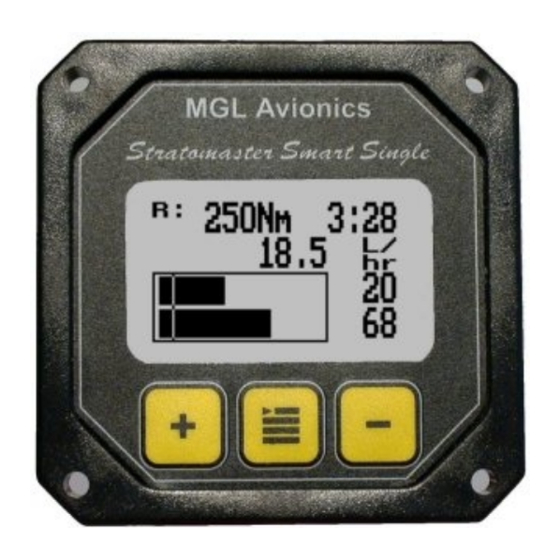
Table of Contents
Advertisement
Quick Links
Stratomaster Smart Single
FF-1
Fuel management system
Fuel flow, fuel range, fuel endurance, fuel level
The FF-1 fuel management computer is a 2.25" instrument intended for efficient monitoring of fuel
related information onboard small aircraft.
The FF-1 unit can connect to a fuel flow sender, fuel level sender or both. Full functionality is
available with both senders or only with a fuel flow sender using calculated fuel levels based on
fuel usage.
Standard automotive fuel level senders can be used, even with odd shaped tanks thanks to a
comprehensive, multi point calibration system.
Most fuel flow senders can be used and the K-factor of the sender can be entered into the system
for simple calibration. MGL Avionics supplies a lightweight dual range fuel flow sender that is
ideally suited for the FF-1 unit.
Advertisement
Table of Contents

Summary of Contents for MGL Avionics Stratomaster Smart Single
- Page 1 Most fuel flow senders can be used and the K-factor of the sender can be entered into the system for simple calibration. MGL Avionics supplies a lightweight dual range fuel flow sender that is ideally suited for the FF-1 unit.
- Page 2 The main display Fuel range Fuel endurance hours:minutes Fuel low Fuel flow alarm level Fuel level Remaining fuel Setting up the FF-1 Press the Menu key to enter the menu. You can move forward and backwards in the menu by using the + and –...
- Page 3 Fuel This function is used to manually enter your current fuel level after fueling or defueling your aircraft. This function is only available if you do not have a fuel level sender connected or you have disabled it using the relevant menu function. If you only have a fuel flow sender this function is used to enter your available fuel.
- Page 4 The calibration procedure should be carried out with your aircraft in flight attitude. This means you need to lift the tail if you have a tail-dragger or lift the nose wheel if you have a weightshift trike. You start the calibration procedure with an empty tank. Your first determination should be how much reserve fuel you should carry.
- Page 5 The instrument uses the 6 calibration points to work out a correction curve that takes into account the tolerances of your fuel level sender and the shape of your fuel tank. This results in an incredibly accurate and usable fuel level display that far exceeds that available from ordinary dial type gauges.
- Page 6 The K-Factor is the number of pulses generated by the fuel flow sender for one liter of fuel. The dual range fuel flow sender supplied by MGL Avionics has a K-Factor of 7000 in the low flow mode (jet installed) and 1330 for the high flow mode (no jet installed).
- Page 7 Weight: 90 grams. Warranty: MGL avionics warrants their products for a period of one year from date of purchase against faulty workmanship. Warranty is limited to the replacement of faulty components and includes the cost of labor. Shipping costs are for the account of the purchaser.
- Page 8 Please observe the installation notes supplied with the fuel flow sender. Should you install a different fuel flow sender to that supplied by MGL Avionics, ensure that you enter the K-factor relevant for your sender. Some senders require a pull-up resistor to the 12V supply line. We find most installations of these senders require a 4K7 pull-up resistor.
















Need help?
Do you have a question about the Stratomaster Smart Single and is the answer not in the manual?
Questions and answers